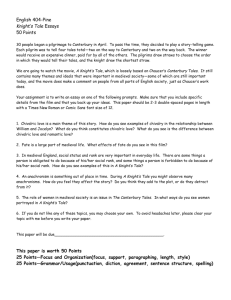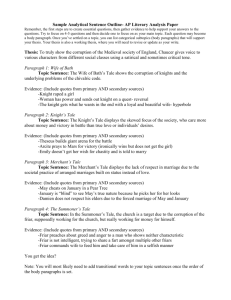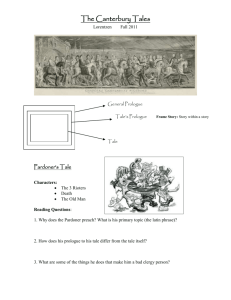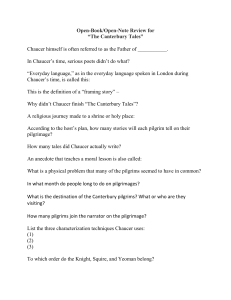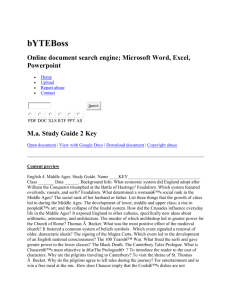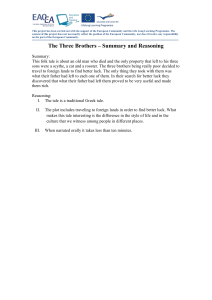It would be a fairly simple argument to show Geoffrey Chaucer`s
advertisement
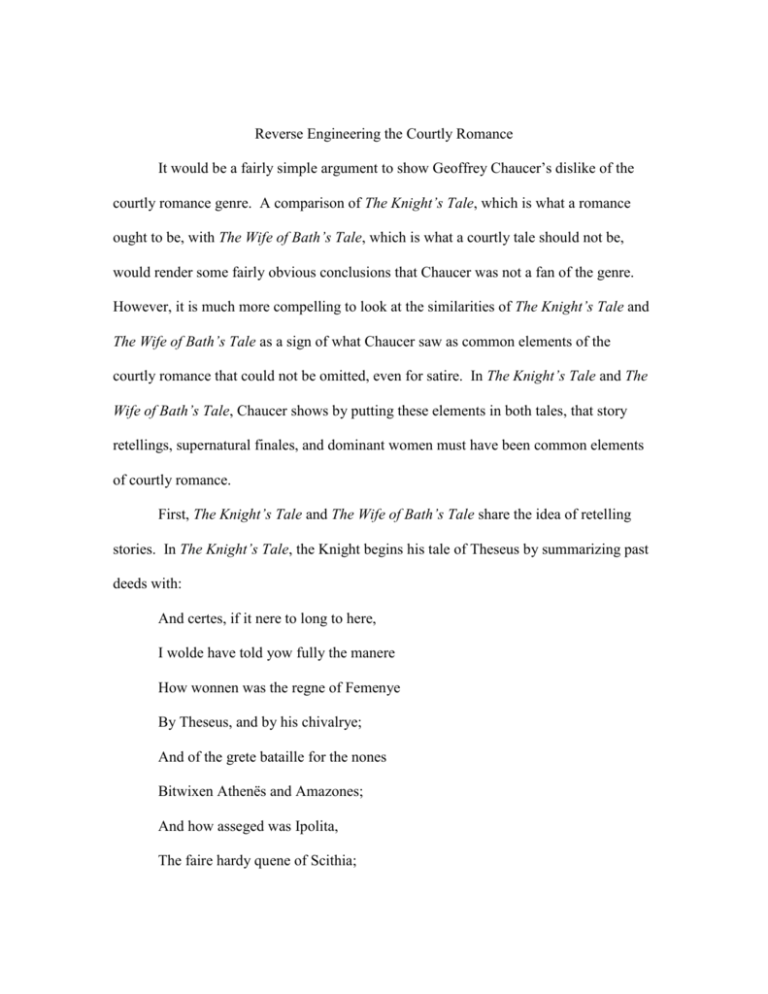
Reverse Engineering the Courtly Romance It would be a fairly simple argument to show Geoffrey Chaucer’s dislike of the courtly romance genre. A comparison of The Knight’s Tale, which is what a romance ought to be, with The Wife of Bath’s Tale, which is what a courtly tale should not be, would render some fairly obvious conclusions that Chaucer was not a fan of the genre. However, it is much more compelling to look at the similarities of The Knight’s Tale and The Wife of Bath’s Tale as a sign of what Chaucer saw as common elements of the courtly romance that could not be omitted, even for satire. In The Knight’s Tale and The Wife of Bath’s Tale, Chaucer shows by putting these elements in both tales, that story retellings, supernatural finales, and dominant women must have been common elements of courtly romance. First, The Knight’s Tale and The Wife of Bath’s Tale share the idea of retelling stories. In The Knight’s Tale, the Knight begins his tale of Theseus by summarizing past deeds with: And certes, if it nere to long to here, I wolde have told yow fully the manere How wonnen was the regne of Femenye By Theseus, and by his chivalrye; And of the grete bataille for the nones Bitwixen Athenës and Amazones; And how asseged was Ipolita, The faire hardy quene of Scithia; And of the feste that was at hir weddinge, And of the tempest at hir hoomcominge; But al that thing I moot as now forbere. (875-885) This summary of past events is a common element of courtly romances. The Knight entices the audience by saying he can say no more, then proceeds to say more. Similarly, the Wife of Bath interjects the story of Midas and his wife into her tale with: Ovyde, amonges othere thinges smale, Seyde Myda hadde under hin longe heres, Growinge upon his heed two asses eres, The whiche vyce he hidde as he best might Ful subtilly from every mannes sighte, That, save his wyf, ther wiste on it namo. He loved hire most, and trusted hire also; He preyede hire that to no creature She sholde tellen of his disfigure. ...Heer may ye se, thogh we a tyme abyde, Yet out it moot, we can no conseil hyde. The remenant of the tale if ye wol here, Redeth Ovyde, and ther ye may it lere. (952-982) The Wife’s side tale is much more related to her main tale than the Knight’s. It is a tale of the relationship between a husband and wife and trust, which is also what her main tale is about. Here, one can also see Chaucer’s negative view on retelling classical stories as if they are authoritative. “Ovyde’s” tale does not “redeth” quite as the Wife pretends. There is a similar instance in The Knight’s Tale where the Knight tells a classical tale incorrectly. He describes the rest of Theseus’ days as: And whan this worthy duk hath thys y-don, He took his host, and homm he rit anon With laurer crowned as a conquerour; And there he liveth in joye and in honour Terme of his lyf; what nedeth wordes mo? (1025-1029) Theseus never exactly “liveth in joye and in honour” after the fake events the Knight lays out in the story. In fact, The Knight’s Tale pretends to be an authoritative classical tale but is completely made up. This only adds to Chaucer’s attitude that courtly romances are not that accurate when it comes to classical references. Yet, because he makes strong classical references in both tales that are seemingly opposites, it shows a commonality in the genre. Second, both tales contain several supernatural elements. In The Knight’s Tale, an entire section of the tale is spent describing the temple to the gods and the prayers to the gods. Since these are pagan classical gods for Chaucer, one could define them as supernatural rather than divine. On top of the prayers, the battle for Emily’s hand is directly determined by the gods with: Out of the ground a furie infernal sterte, From Pluto sent at requeste of Saturne, For which his hors for fere fan to turne And leep asyde, and foundred as he leep; And er that Arcite may taken keep, He pighte him on the pomel of his heed, That in the place he lay as he were deed, His brest tobrosten with his sadel-bowe. (2684-2691) The supernatural element is a prominent action in the story that solves the question of Emily’s fate. Without it, the battle may yet be undetermined. In The Wife of Bath’s Tale, the supernatural also plays a key role. First the knight is led to the wyf by an illusion with: The day was come that hommward moste he tourne, And in his wey it happed him to ryde In al this care under a forest-syde, Wheras he saugh upon a daunce go Of ladies foure and twenty and yet mo; Toward the whiche daunce he drow ful yerne, In hope that som wisdom sholde he lerne. But certeinly, er he came fully there, Vanisshed was this daunce, he niste where. (988-996) Without the mirage in the forest, the knight would be dead and the tale would be over. A further element of the supernatural in the tale is when the wyf offers the knight a choice: “Chese now,” quod she, “oon of thise thinges tweye: To han me foul and old til that I deye And be to yow a trewe humble wyf, And nevere yow displese in al my lyf, Or elles ye wol han me yong and fair, And take youre aventure of the repair That shal be to youre hous, by cause of me, Or in som other place, may wel be. Now chese yourselven whether that yow lyketh.” This knight avyseth him and sore syketh, But atte laste he seyde in this manere: “My lady and my love, and wyf so dere, I put me in youre wyse governance: Cheseth youreself which may be most plesance And most honour to yow and me also. I do no fors the whether of the two, For as yow lyketh, it suffiseth me.” (1219-1235) The fact that she offers him a choice of ugly but faithful or pretty but unfaithful is not really all that supernatural. The fact that she has the power to make the decision through magic definitely is. Since the wyf already lured the knight into her grove to help spare is life can lead to only one conclusion: the knight married a witch! The supernatural plays a major role in both tales and therefore Chaucer may have thought if he did not include them, it would make the satire of the courtly romance less believable. The third and most powerful similarity between the two tales is the dominance of women over men. The power is not necessarily obvious. In The Knight’s Tale, King Theseus appears to be in complete control over his kingdom. During his wedding precession the Knight relates: This duk, of whom I make mencioun, When he was come almost unto the toun, In all his wele and in his moste pryde, He was war, as he caste his eye asyde, Where that ther kneled in the hye weye A companye of ladies, tweye and tweye, Ech after other clad in clothes blake; But swich a cry and swich a wo they make, That in this world nis creature livinge, That herde swich another weymentinge; And of this cry they nolde nevere stenten, Til they the reynes of his brydel henten. (893-904) Theseus is quite hardened by the women’s actions at first, but when he finds their distress he immediately rushes to invade a city to avenge their husbands’ deaths. Even though Theseus thinks he is in charge, he is leaving his own wedding at the behest of more women. Theseus later shows subservience with: The quene anon, for verray wommanhede, Gan for to wepe, and so dide Emelye, And alle the ladies in the companye. Gret pitee was it, as it thoughte hem all, That ever swich a chaunce sholde falle; For gentil men they were of greet estat, And no thing but for love was this debat; And sawe hir blody woundes wyde and sore, And alle cryden, bothe lasse and more, “Have mercy, lord, upon us wommen alle!” And on hir bare knees adoun they falle, And wolde have kist his feet ther as he stood, Til at the laste aslaked was his mood; For pitee renneth sone in gentil herte. (1748-1761) Here, Theseus is dead set on killing Arcite and Palamon until his womenfolk ask him not to. Then he does a complete about face at their behest. The women have some dominance over their men in this tale. Likewise, in The Wife of Bath’s Tale, the entire point of the story is that women want dominance and sovereignty over their men. The first instance of this dominance is between Arthur and his queen with: For which oppressioun was swich clamour And swich pursute unto the King Arthour, That dampned was this knight for to be deed By cours of lawe, and sholde han lost his heed – Paraventure swich was the statut tho – But that the quene and othere ladies mo So longe preyeden the king of grace Til he his lif him graunted in the place, And yaf him to the quene al at hir wille, To chese whether she wolde him save or spille. (889-898) Like Theseus, Arthur is dead set on doing on killing the knight but the pleadings of the ladies sway him. Similar to the widows in The Knight’s Tale, they aren’t so much as pleading for mercy, but pleading for justice. The queen, now having her sovereignty commands the knight to find what women desire. The knight in turn becomes dependent on a woman for the answer with: “Plighte me they trouthe, heer in myn hand,” quod she, “The nexte thing that I requere thee, Thou shalt it do, if it lye in they might, And I wol telle it yow er it be night.” (1009-1012) In this case, the old wyf has dominance over the knight because if he does not agree to what she asks, she can simply not tell him what women desire and the knight will lose his head. She then exerts her dominance by making him marry her. The knight protests with: This knight answerde, “Allas and weylawey! I woot right wel that swich was my biheste. For Goddes love, as chees a newe requeste: Tak al my good, and lat my body go.” “Nay thanne,” quod she, “I shrewe us nothe two! For thogh that I be foul and old and pore, I nolde for al the metal ne for ore That under erthe is grave or lyth above But if they wyf I were, and eek thy love.” (1058-1066) The wyf is able to use not only his word of honor against him, but also the queen’s presence as leverage. Chaucer must have seen this feminine dominance, either unknowingly in The Knight’s Tale or scheming as in The Wife of Bath’s Tale as a common theme in courtly romances. He may have shifted say feminine influence into dominance to make a point, but the basic idea must have been prevalent in earlier works. In conclusion, The Knight’s Tale and The Wife of Bath’s Tale share elements of a courtly romance story. Both have added classical histories (albeit sometimes incorrect histories), both have the supernatural, and both have dominant women. Between the two stories the “authors” had different goals and points to make to their fellow pilgrims on the way to Canterbury. But the similarities show what is a must in courtly romance. The three similar elements reflect what Chaucer must have seen as essential to writing anycourtly romance, even if it was a unique and satirical one.
